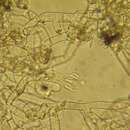pt-BR
nomes no trilho de navegação


Die Traubenbasidien (Botryobasidium) sind eine Gattung corticioider Pilze, deren Fruchtkörper ein auffallend lockeres Hymenium bilden, welches durch ausladend kandelaberartig rechtwinklig verzweigte Hyphen gebildet wird. Die Basidien tragen meist mehr als vier (bis zu acht) Sporen. Viele Arten bilden auch asexuelle, anamorphe Stadien. Es handelt sich um entfernte Verwandte des Pfifferlings (Ordnung der Pfifferlingsartigen)[1].
Die Typusart ist Botryobasidium subcoronatum.[2]
Die Fruchtkörper sind resupinat, dünn, flockig, spinnwebartig oder fein körnelig unter der Lupe und bilden keine völlig glatte Oberfläche aus.[3][4]
Das Hyphensystem ist monomitisch, die Hyphen sind generell breiter als 8 µm, nur sehr locker verwoben und auffällig rechtwinklig verzweigt. Die Basalhyphen nahe dem Substrat sind mehr oder weniger deutlich dickwandig.[3][4]
Die Basidien werden in kleinen Büscheln aus kandelaberartigen Hyphen gebildet. Jung sind sie fast halbkugelig bis abgeschnitten ellipsoid (wegen des geraden Septums), später gestreckt, subzylindrisch und bisweilen median etwas eingeschnürt. Die Basidien tragen bis zu acht Sporen. Nach Abwurf der Sporen und beim Trocknen der Fruchtkörper kollabieren die Basidien, was die Bestimmung getrockneter Proben erschwert.[3]
Die Sporen sind meist glatt, können aber bei wenigen Arten auch warzig (z. B. bei Botryobasidium asperulum) bis stachelig (z. B. bei Botryobasidium isabellinum) ornamentiert sein. Sie sind farblos-hyalin, inamyloid und ellipsoid bis schiffchenförmig (bzw. zitronenförmig), seltener auch kugelig. Eine sekundäre, repetitive Sporenkeimung tritt nicht auf.[4]
Hymenialzystiden können auftreten, fehlen aber meist.[4]
Einige Arten treten auch als Anamorphes Stadium auf (Oidium- und Haplotrichum-Typ).[3][4]
Die Lebensweise ist unklar. Das Auftreten vieler Arten auf Totholz, auch in der Luft ohne direkten Bodenkontakt des Fruchtkörpers, lässt eine saprobe Lebensweise vermuten. Verwandte Gattungen wie Keulenpilze (Clavulina) und Stoppelpilze (Hydnum) bilden hingegen Ektomykorrhizen aus[5]. Arten der ebenfalls verwandten Gattung Ceratobasidium sind hingegen als Symbionten von Orchideen (Orchideen-Mykorrhiza) bekannt und zugleich aber auch teils phytopathogen[6]. Bei der Orchideengattung Apostasia wurden auch Botyobasidium-Arten als Mycobiont nachgewiesen.[7]
Die Gattung kommt weltweit vor (ca. 80 Arten, Stand 2008).[8]
In Europa kommen ca. 24 Arten in ihrem sexuellen Stadium vor[4][9], die sich teils so sehr ähneln, dass für eine Bestimmung manchmal das anamorphe Stadium nötig ist.[4]
Ausgewählte Arten:
Die Traubenbasidien wurden früher zusammen mit anderen Pilzen, die einfache, dem Substrat anliegende, corticioide Fruchtkörper bilden, in die künstliche Formgruppe der Corticioiden Pilze bzw. in eine polyphyletische, große Familie der Corticiaceae gestellt.[3] Molekular-phylogenetische Studien zeigten aber einerseits die Polyphylie der Corticiaceae im weiteren Sinn und die Zuordnung der Traubenbasidien zu den Pfifferlingsartigen.[10][1] Die Vertreter der Gattung Ceratobasidium sind nicht nur anatomisch sehr ähnlich – sie unterscheiden sich im Prinzip nur durch die repetitiven Sporen[3] – sondern stehen auch genetisch nah, weshalb die Traubenbasidien zunächst in die Familie der Ceratobasidiaceae gestellt wurden.[1] Mittlerweile werden sie in eine eigene Familie gestellt, die je nach Gattungsauffassung im Moment monotypisch ist oder mit der Gattung Botryohypnochus eine zweite Gattung enthält.[10]
Gitta Langer (1994): Die Gattung Botryobasidium Donk (Corticiaceae, Basidiomycetes). Bibliotheca Mycologica 158: 1–459. Berlin: J. Cramer. ISBN 3-443-59060-8.
Die Traubenbasidien (Botryobasidium) sind eine Gattung corticioider Pilze, deren Fruchtkörper ein auffallend lockeres Hymenium bilden, welches durch ausladend kandelaberartig rechtwinklig verzweigte Hyphen gebildet wird. Die Basidien tragen meist mehr als vier (bis zu acht) Sporen. Viele Arten bilden auch asexuelle, anamorphe Stadien. Es handelt sich um entfernte Verwandte des Pfifferlings (Ordnung der Pfifferlingsartigen).
Die Typusart ist Botryobasidium subcoronatum.
Botryobasidium is a genus of corticioid fungi belonging to the order Cantharellales. Basidiocarps (fruit bodies) are ephemeral and typically form thin, web-like, white to cream, effused patches on the underside of fallen branches, logs, and leaf litter. Several species form anamorphs producing chlamydospores. All species are wood- or litter-rotting saprotrophs and the genus has a worldwide distribution.
The genus was first described by Dutch mycologist M.A. Donk in 1931.[2] Species had previously been referred to the genus Corticium, formerly used for most corticioid fungi with effused fruit bodies. Donk recognized a group of species within Corticium that (microscopically) produced basidia in "botryose" clusters (hence Botryobasidium), had wide, often right-angled hyphae, large two- to eight-spored basidia, and smooth basidiospores. He described a second genus, Botryohypochnus, for species with ornamented basidiospores.[2] The genus was later monographed by Langer (1994) who included Botryohypochnus within the generic concept of Botryobasidium.[3]
Asexual anamorphic forms, producing chlamydospores but not basidia and basidiospores, had been treated separately and given a variety of generic names. These were reviewed by Holubová-Jechková (1980) who considered most of these genera synonymous with Haplotrichum, the anamorphic state of Botryobasidium.[4]
Following changes to the International Code of Nomenclature for algae, fungi, and plants, the practice of giving different names to teleomorph and anamorph forms of the same fungus has been discontinued, meaning that Haplotrichum and other anamorph genera have become synonyms of Botryobasidium.[5] Molecular research, based on cladistic analysis of DNA sequences, indicates that the genus (including Botryohypochnus) is monophyletic and forms a natural group within the Cantharellales.[6]
Botryobasidium is a genus of corticioid fungi belonging to the order Cantharellales. Basidiocarps (fruit bodies) are ephemeral and typically form thin, web-like, white to cream, effused patches on the underside of fallen branches, logs, and leaf litter. Several species form anamorphs producing chlamydospores. All species are wood- or litter-rotting saprotrophs and the genus has a worldwide distribution.
Botryobasidium Donk (pajęczynowiec) – rodzaj grzybów należący do rodziny pajęczynowcowatych (Botryobasidiaceae)[1].
Pozycja w klasyfikacji: Botryobasidiaceae, Cantharellales, Incertae sedis, Agaricomycetes, Agaricomycotina, Basidiomycota, Fungi (według Index Fungorum)[1].
Synonimy naukowe: Botryohypochnus Donk, Cyanohypha Jülich[2].
Nazwę polską podał Władysław Wojewoda w 1996 r[3].
Wykaz gatunków (nazwy naukowe) na podstawie Index Fungorum[4]. Nazwy polskie według checklist Władysława Wojewody (pominięto nazwy podane przez W. Wojewodę w 2003 r. a niespójne z obecną nazwą naukową[3].
Botryobasidium Donk (pajęczynowiec) – rodzaj grzybów należący do rodziny pajęczynowcowatych (Botryobasidiaceae).
Botryobasidium é um gênero de fungo pertencente à família Botryobasidiaceae.[1][2]
Botryobasidium pteridophytorum
Botryobasidium é um gênero de fungo pertencente à família Botryobasidiaceae.